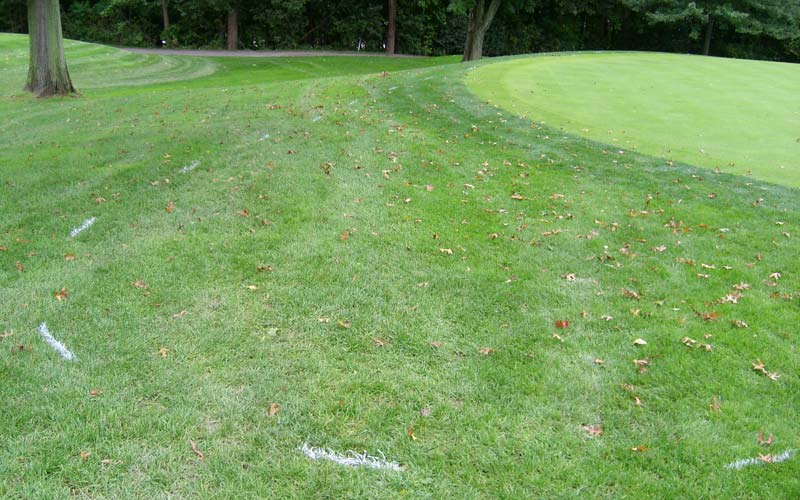Kirtland Country Club Green Expansion
by Chad A. Mark,Golf Course Superintendent
May, 2008
One of the most beneficial and exciting aspects of our Restoration at Kirtland has been the green expansion process. It all started with Ron Forse and Jim Nagle reviewing several historic aerials of the Club to obtain the original Alison green and bunker shapes. The other fortunate aspect in identifying areas of reclamation was that there has not been a lot of disturbance or construction at the Club in the past and the expansion areas were most often very obvious once we were in the field with the design team. In the spring of 2006, Jim Nagle painted the green expansions in the field and we began the following reclamation process.
Fall 2005/Spring 2006
Knowing that the green expansion and bunker restoration project was planned for 2007 we had time to grow suitable sod for the project on site. Using aerification cores from our poa annua/bentgrass greens we established twenty thousand square feet of nursery stock located on our Junior Course (former skeet range). This sod would be used for all of the expansions located in rough areas, typically the back corners of the reclaimed space. In areas of approaches that were expanded (squared front sections of the green) we began to lower the height of cut, and also aerify and topdress the areas frequently.
Fall 2006/Spring 2007
After performing soil tests on the expansion areas we began to amend the soil with sand and nutritional amendments needed to correct present deficiencies. Our goal was to have the reclaimed areas closely match the existing green fertility and begin the process of implementing sand into the top of our rootzone. Our native soil has tremendous structure and for that reason we chose to use this type of amending technique vs. excavation of existing soil and replacing with a construction mix. The Club’s Agronomic Consultant, Mr. Richard Bator, who was also the Head Superintendent at the Kirtland Club in the mid 90’s, was very involved in the expansion recommendation process. He was on site several times during the planning phase of the project and agreed with the decision to amend soil due to the fact that it would give us more consistency in the future. Mr. Bator felt the use of construction mix would present challenges in our fertility and water management programs that were unnecessary due to the fine soil present at Kirtland.
August 2007
The formal process of expanding greens began in conjunction with the bunker restoration on August 7th 2007. The following is the typical process used to reclaim the green contours.
1. Removal of the existing turf from the pre-marked area. Turf is removed at least ½” lower than the thatch layer.
2. Once the thatch was removed we then aerified 3-4″ deep with 5/8″ hollow tines. Once these cores were pulled we hand swept sand and amendments into the profile. Once the holes were filled we then repeated the procedure two more times. Plugs of soil were incorporated with the sand. Amendments and fertilizer were only applied on the first aerification.
3. Once the holes were filled we then used 60-20-20 construction mix (determined to closely match the top 3″ of our existing profile) to level the expansion area. The area was compacted and leveled to our desired grade. The slope and contour of the expansion was determined by the grade of the existing green. A 6 ft carpenter’s level was used to find the percentage slope of these areas. It was our intention to slightly soften the areas but to retain the character of the 1921 greens by holding true to the prevailing slope.
4. Once the grade was at our desired slope and height we brought in the nursery sod that had been created in 2005. The nursery sod was maintained at regular greens height throughout the season. In order to have the best chance of having a successful expansion, we knew we would need to cut the sod as thick as possible. Therefore, the sod was cut approx. 1.25″ thick and only in sections of 12 to 20 inches long. This made it harder to handle the sod but in the long run it helped rooting and limited the shifting that often occurs early in the establishment process. Having small pieces of sod made this part of the process time consuming but was probably the most important piece of our successful expansion project.
5. After the sod was laid we then topdressed the area with sand paying close attention to the seams. The area was then rolled repeatedly on a daily basis.
6. Within two days of completion the areas were mowed at the current greens mowing height. Any scalping was topdressed and brushed.
7. Within 7 days of completion the areas were hydrojected to encourage root development.
8. Within 30 days of completion the areas were aerified and topdressed using 5/8″ tines. This will be an ongoing monthly process until we feel the root systems and health of the expansions closely resemble the existing green surfaces.
Pictures of the green expansion process:
|
The End












